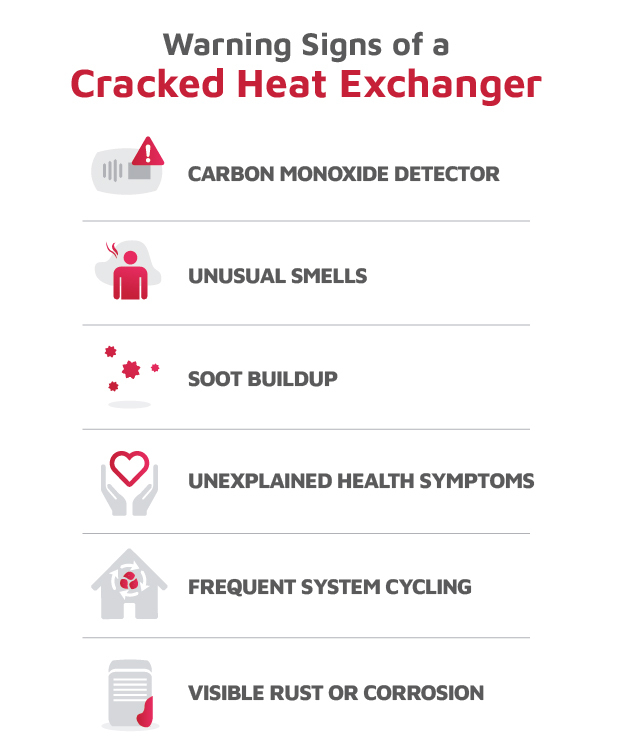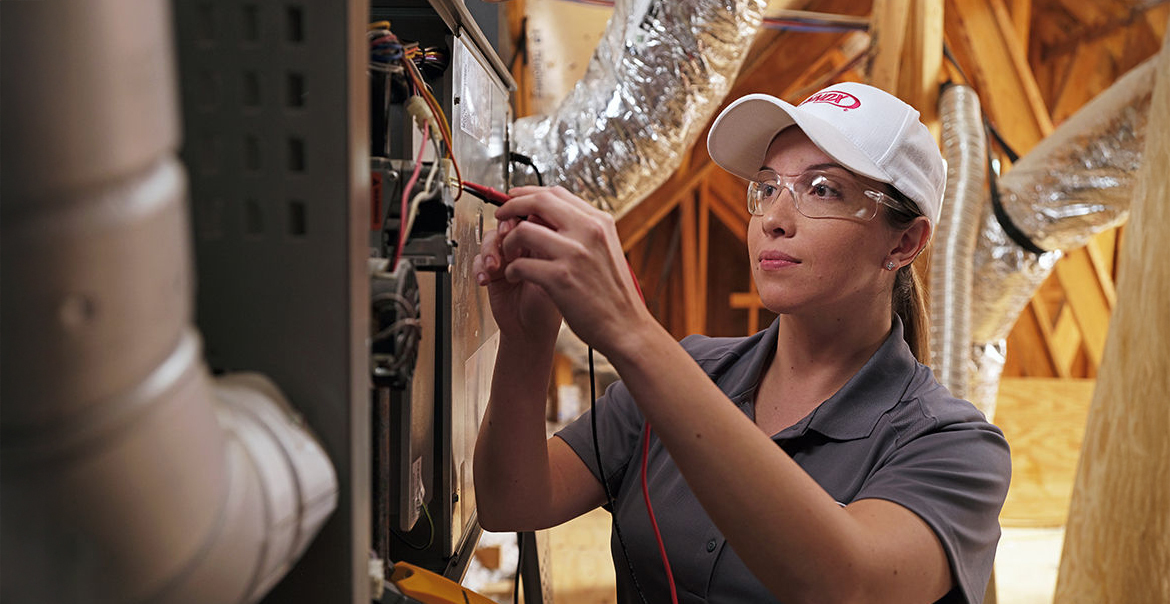Understanding the Importance of this Critical Furnace Component
When temperatures drop, your furnace becomes one of the most important systems in your home. But hidden inside this essential equipment lies a component that, if damaged, can pose serious risks to your comfort – and your safety. It’s called the heat exchanger.
Though replacing a cracked furnace heat exchanger may be a costly, avoiding repair can be dangerous. Continuing to run your furnace with a damaged heat exchanger will not only cause reduced heating efficiency, it can result in carbon monoxide leaks – a dangerous health hazard. Being aware of the signs and causes of this issue, and understanding the solutions, can help homeowners protect their families and avoid unexpected breakdowns.
What Is a Furnace Heat Exchanger?
The heat exchanger is one of the most critical components in a furnace. It’s responsible for transferring heat, created by the combustion gases inside it, to the air that circulates through your home. The metal walls of the exchanger keep harmful gases, such as carbon monoxide, safely separated from your indoor air while allowing heat to pass through efficiently.

When the heat exchanger is intact and functioning properly, your furnace should deliver safe, even heat throughout your home. However, if cracks develop, those same combustion gases can escape into the air you breathe, creating a serious safety concern.
The Importance of Heat Exchangers in Furnace Efficiency
Beyond safety, a furnace’s heat exchanger is key to its efficiency. Cracks, rust, or buildup can affect this process, forcing the system to burn more fuel and run longer. Regular maintenance can help preserve efficiency, reduce energy costs, and extend your furnace’s lifespan.
What Causes a Heat Exchanger to Crack?
Cracks can form over time due to natural wear, improper system operation, lack of maintenance, or improper static pressure. Some of the most common causes include:
- Age and metal fatigue
Each time your furnace heats up and cools down, the metal in the heat exchanger expands and contracts. After years of cycles, this can cause the metal to weaken and eventually crack. - Restricted airflow or dirty filters
Poor airflow causes your furnace to overheat. When the metal gets too hot, it can warp or split, especially in older systems. - Oversized or short-cycling furnaces
A furnace that turns on and off too frequently experiences additional stress. Incorrect system sizing or poor duct design can accelerate wear on the exchanger. - Corrosion and rust
Excess moisture in or around the furnace can lead to corrosion, weakening the exchanger’s metal walls and making cracks more likely.
Warning Signs of a Cracked Heat Exchanger
A cracked heat exchanger isn’t always visible, but there are several signs that can alert you to trouble:

- Carbon monoxide detector: If your carbon monoxide detector’s alarm goes off, or the parts per million (ppm) reading is above 30 ppm, you may have a cracked exchanger.
- Unusual smells: A burning, metallic, or chemical odor coming from the furnace may signal a problem.
- Soot buildup :Excess soot around burners or vents can indicate incomplete combustion caused by a crack.
- Unexplained health symptoms: Headaches, nausea, dizziness, or fatigue may result from low-level carbon monoxide exposure.
- Frequent system cycling: Short heating cycles or inconsistent temperatures often point to airflow or combustion issues linked to a damaged exchanger.
- Visible rust or corrosion: Physical deterioration around the furnace or flue pipes can be an early warning sign.
If you notice any of these issues, it’s important to have your furnace inspected by a qualified HVAC professional right away.
The Dangers of a Cracked Heat Exchanger
A crack in the heat exchanger can allow carbon monoxide (CO) — a colorless, odorless, and potentially deadly gas — to escape into your home. Prolonged exposure to CO can cause serious health problems and, in severe cases, be life-threatening.
Even if carbon monoxide isn’t detected, a cracked exchanger can reduce your furnace’s efficiency. In extreme cases, damage can lead to overheating or even a fire risk which can also be life-threatening.
For peace of mind, every home should be equipped with carbon monoxide detectors on each level, particularly near bedrooms and living spaces.
What to Do If You Suspect a Crack?
If you believe your furnace may have a cracked heat exchanger, take the following steps immediately:
- Shut off the furnace. Stop operation to prevent further damage or exposure to combustion gases.
- Ventilate your home. Open doors and windows to allow fresh air circulation.
- Contact an HVAC professional. A certified technician can perform diagnostic testing, such as combustion analysis or visual inspection, to confirm the issue.
Because the heat exchanger is a sealed component, repairs are rarely recommended. Typically, replacement of the exchanger is the safest and most cost-effective solution. In some cases, depending on the age of the system or the presence of additional damage caused by the cracked heat exchanger, it may be necessary to replace the entire furnace.
Preventing Future Damage
Regular furnace maintenance is the best defense against a cracked heat exchanger. Here are a few preventive steps:
- Schedule annual furnace tune-ups before each heating season to identify potential issues early.
- Replace air filters regularly to maintain proper airflow.
- Keep vents and registers unblocked to prevent overheating.
- Ensure your furnace is properly sized and installed by a licensed professional.
With routine care, a high-quality furnace can provide years of safe, reliable comfort.
A cracked heat exchanger should never be ignored. It’s more than a mechanical problem — it’s a safety concern. If you notice unusual furnace behavior, uneven heating, or persistent odors, reach out to a local HVAC professional for an expert inspection. Prompt professional attention ensures your family stays warm, comfortable, and safe all winter long.

